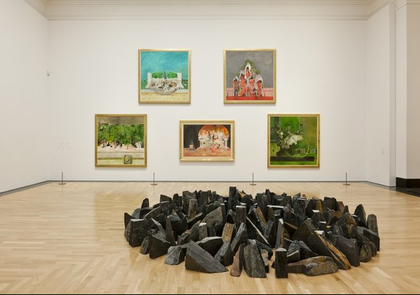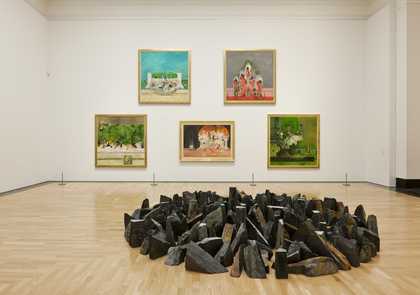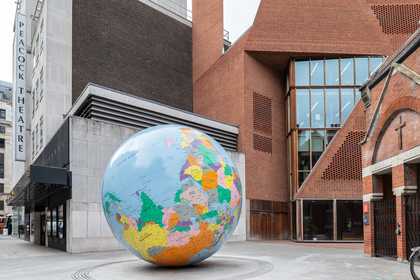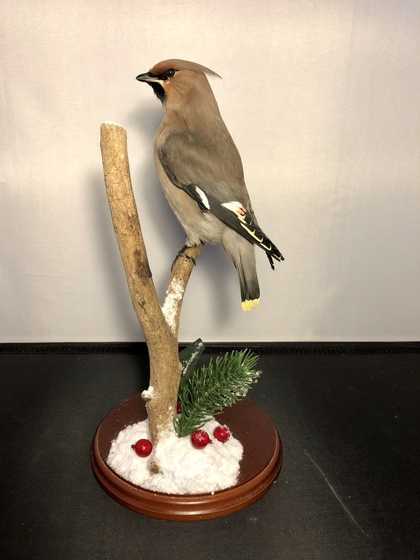
Gallery view, National Museum Cardiff
┬® Amgueddfa Cymru ŌĆō National Museum Wales
Museum Research in Turbulent Times and/or the Importance of ŌĆśStaying with the TroubleŌĆÖ
EMILY PRINGLE
It has become self-evident to the point of clich├® to state that art museums and the wider society in which they operate are existing in turbulent times. The crisis engendered by Covid-19 is impacting the museum sector across the globe, forcing first closures, then highly restricted re-openings. Within and beyond the sector there is active questioning of the museumŌĆÖs purpose prompted not only by the pandemic, but also by ever more urgent debates concerning decolonisation and the need for cultural institutions to tackle systemic racism within and beyond their organisations. Unable to welcome visitors into their buildings in pre-Covid numbers, art museums are needing to reconsider systems and structures in their entirety. Economic models, audience engagement strategies, staffing structures, collection acquisition and care priorities and exhibition programmes are being swiftly reframed to try and ensure institutional survival.
In these rapidly shifting and unquestionably testing times museums are responding in different ways. Some museums have responded to the emergency by embracing their civic responsibilities.1 Others, faced with critical reductions in revenue that threaten their continuing existence, are seemingly focusing all their energies on reducing staff numbers, securing financial bailouts and income generation.2 Many have made ambitious statements voicing their solidarity with the Black Lives Matter movement that reignited following the death of George Floyd in America in February 2020. There have been commitments made to tackling white supremacist cultures and embedding anti-racism practices. At the same time, museums are needing to radically rethink their digital offer, recalibrating the relationship between physically accessible displays and exhibitions and online collections and public programmes.
Given these circumstances, it is timely to interrogate how research operates within museums. The contributions brought together here interrogate this question in various ways. Initially submitted for the 2020 British Art Network conference ŌĆśResearch and the Museum EcosystemŌĆÖ that was due to take place at the National Museum of Wales in Cardiff in March 2020, these papers have been reworked by the authors as online presentations. Viewing them together it is possible to see connections and key themes, which arguably have grown in significance in the last seven months.
So, what role can research play, when institutional survival and ethical anti-racist practice need to be a priority for museums? In exploring this question, it is perhaps helpful to consider research, not in discipline specific terms, but more broadly as an epistemological process. It is this theoretical framing which ├ōl├Čf Ger├░ur Sigf├║sdottir explores in her presentation, offering us insights into the development of and affordances provided by museums as alternative knowledge producing spaces. For ├ōl├Čf, museum research is an epistemological process that generates embodied knowledge which is manifest through practice. Similarly, in my own research I have come to define research as constituting a process of questioning, analysis and reflection which takes place through structured enquiry and which leads to new insights that go out into the world.3 Understood in these terms, research can be understood as an intellectual (and I would argue emotional) space where museum professionals and others can pose questions and generate new knowledge about the urgent challenges and issues facing these institutions today. Research in the museum, be it art historical exploration, museological study, pedagogic investigation or conservation experimentation offers a space of possibility, speculation and imagining as well as rigorous examination and thought. It necessitates total immersion in a problem yet also requires periodic stepping back to be able to reflect, make connections, contextualise and draw conclusions. Crucially, when individuals adopt the persona of the researcher, they are explicitly tasked with interrogating something to understand it more deeply and differently, indeed often in order to change it.
This is why research is needed ever more urgently in museums at present. The complexity of the challenges that museums face requires a commitment on the part of those working within and alongside them, in the words of theorist Donna J. Haraway to ŌĆśstay with the troubleŌĆÖ.4 Haraway describes what it takes to stay with the trouble in these terms:
WeŌĆ” live in disturbing times, mixed-up times, troubling and turbid times. The task is to become capable, with each other in all of our bumptious kinds, of responseŌĆ”. Our task is to make trouble, to stir up potent response to devastating events, as well as to settle troubled waters and rebuild quiet placesŌĆ”. Staying with the trouble requires learning to be truly present, not as a vanishing pivot between awful or Edenic pasts and apocalyptic or salvific futures, but as mortal critters entwined in myriad unfinished configurations of places, times, matters, meanings.5
What Haraway is advocating is that firstly we must respond to this challenging situation from the position we find ourselves in; from the present moment. We must avoid nostalgia for an already idealised past, or project ourselves forward to a hazy, as-yet unimaginable future. The priority is to tackle the situation as we find it. She talks too of settling ŌĆśtroubled watersŌĆÖ and rebuilding ŌĆśquiet placesŌĆÖ as well as stirring up potent responses. In other words, action and response are essential now, but so is questioning and deep thinking so that we understand the value of what we are changing. We need to do, but also to review and examine what it is we are doing, why and for whom, to learn how best to negotiate our ŌĆśunfinishedŌĆÖ present.
Research can help with this process of staying with the trouble to bring about change. Research, not least through the asking of questions, creates space for people to challenge existing structures, to question dominant narratives and offer alternative interpretations. HarawayŌĆÖs call to ŌĆśstir up potent response to devastating eventsŌĆÖ speaks to the urgent need for museums to unearth and make visible hitherto unrepresented histories and perspectives. If museums are to engage in decolonial practices the need is for change at a profound level. Institutions must in the first instance acknowledge transparently their historical and colonial origins. They must accept the extent to which these historical foundations have determined what is present in their collections as well as how these objects are represented. Furthermore, they need to take account of how museum cultures and practices have perpetuated the dominance of some and the erasure of other perspectives, histories and voices across the institution to the present day. The expectation is that museums change comprehensively, for as Rachael Minott observes, ŌĆśthe practical application of decolonial theory raises questions that permeate into all levels of museum practiceŌĆÖ.6 It goes without saying that research is vital if the legacies of colonialism and imperialism that underpin institutions and their collections are to be surfaced and acknowledged.
At the start of the ŌĆślockdownŌĆÖ period in March 2020, commentators and practitioners were vocal in making the case for an enhanced civic role for art museums, with museum leaders taking the opportunity to share their ambitions for, in the case of ║┌┴Ž╔ńŌĆÖs Director Frances Morris, a museum that frames ŌĆśart as a social space rather than as a marketplaceŌĆÖ.7 It was conceivable to imagine then that the crisis was ushering in the era of the community-oriented museum. Indeed, as Donna Haraway acknowledges, we are ŌĆśentwined in myriad unfinished configurations of places, times, matters, meaningsŌĆÖ.8 Museums sit within and are themselves complex ecosystems, or configurations, a key observation that both Jillian Sutherland and Mike Tooby/Trish Scott explore in their two respective presentations. Drawing on her research on small UK museums, Jillian argues for entrenched hierarchies to be dismantled and ŌĆśradicalŌĆÖ collaborative curatorial practices to be embraced, not least to make the hidden practices of the museum more visible. Likewise, Tooby and Scott draw on their experience of working on the ŌĆśJourney with The WastelandŌĆÖ exhibition to examine and reflect on what takes place if curators open up their practices and co-research with others. Their presentation offers valuable lessons on the potential benefits to museums of working with members of local communities to co-investigate questions of urgent relevance to both.
Each one of these papers helps answer the question of what role research can play in these turbulent times. By interrogating and surfacing the complexity of the ŌĆśmuseum ecosystemŌĆÖ and drawing attention to the ŌĆśmyriad unfinished configurationsŌĆÖ that Haraway alludes to, the authors provide evidence of how research as a process and practice can make a positive contribution to our understanding of these multifaceted organisations.
Research therefore needs to be located at the centre of the museum now more than ever. Analytic and reflective processes must not be ignored in the rush to address the immediate financial challenges museums are facing. Without opportunities to interrogate their histories, practices, systems and structures, museum professionals risk perpetuating harmful practices and irrelevant structures and alienating the visitors and communities they so urgently need to attract. Alternatively, making time to look inward as well as work with collaborators beyond the museum, be they for example academic researchers, activists, artists or children in shared processes of enquiry affords those same professionals the chance to rethink and reframe their institutions in line with the changing needs of the times.
Museums as Epistemic Institutions
├ōl├Čf Ger├░ur Sigf├║sd├│ttir, Director of Quality Enhancement, Teaching and Research, Iceland University of the Arts
├ōl├Čf reflects on museums as generators of knowledge, focussing on the idea of museum research as an alternative practice in the context of conventional knowledge production and academic research.
ŌĆśWho knows what you do?ŌĆÖ: Radicalism and Restrictions in Small Museum Curating
Jillian Sutherland, Curatorial Fellow, Holburne Museum and PhD Researcher, Bath Spa University
Drawing on emerging themes from the qualitative PhD research project entitled, ŌĆśEngaging CuratorsŌĆÖ, Jillian presents findings from a series of interviews with curators of small museums who were asked the question: ŌĆśWho knows what you do?ŌĆÖ
Developing Collections through Cross-Sector Collaboration: The Midlands Art Papers Model
Sophie Hatchwell, Lecturer in History of Art, University of Birmingham and Carol Thompson, Senior Curator, Wolverhampton Arts and Culture
Sophie and Carol discuss their experience of working together on the Midland Art Papers project, an online open access journal that publishes scholarly articles about regional collections, produced in partnership with thirteen public galleries across the Midlands.
Caretaking Relations
Sharing the outcomes of participatory research and curating, and how methodologies interact with local and professional ecologies
Trish Scott, independent artist, curator and researcher, and Engagement Curator, Goldsmiths, University of London and Mike Tooby, independent curator and researcher & Professor in Art and Design, Bath Spa University
Under a title that reflects the theme of curator as ŌĆścare-takerŌĆÖ Trish and Mike reflect on the curatorial process behind ŌĆśJourneys with ŌĆ£The Waste LandŌĆØŌĆś, a high profile exhibition project culminating in 2018, originated by Turner Contemporary Margate, re-presented at The Herbert and Coventry Cathedral in collaboration with Mead Gallery, Warwick University.



